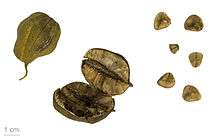Aristolochia clematitis
Aristolochia clematitis, the (European) birthwort, is a twining herbaceous plant in the family Aristolochiaceae, which is native to Europe. The leaves are heart shaped and the flowers are pale yellow and tubular in form. The plant seeks light by ascending the stems of surrounding plants.
| Aristolochia clematitis | |
|---|---|
.jpg) | |
| Scientific classification | |
| Kingdom: | Plantae |
| Clade: | Tracheophytes |
| Clade: | Angiosperms |
| Clade: | Magnoliids |
| Order: | Piperales |
| Family: | Aristolochiaceae |
| Genus: | Aristolochia |
| Species: | A. clematitis |
| Binomial name | |
| Aristolochia clematitis | |

Medicinal problems
It was formerly used as a medicinal plant, though it is poisonous, and is now occasionally found established outside of its native range as a relic of cultivation. It is now thought to be the cause of thousands of kidney failures in Romania, Bulgaria, Serbia, Bosnia and Herzegovina and Croatia where the plant is thought to be unintentionally consumed through contaminated flour, yet contradicted by ongoing research.[1][2] Urinary tract malignancies among those who have consumed the plant are also reported.[3] The link between kidney failure and aristolochic acid, which the plant contains, was discovered after a clinic for obesity in Belgium used herbal products based on another plant of the same genus as a diuretic. After a few months, some of the patients experienced kidney failure.[4]
See also
- Balkan nephropathy
References
- Grollman, A. P.; Shibutani, S.; Moriya, M.; Miller, F.; Wu, L.; Moll, U.; Suzuki, N.; Fernandes, A.; Rosenquist, T.; Medverec, Z.; Jakovina, K.; Brdar, B.; Slade, N.; Turesky, R. J.; Goodenough, A. K.; Rieger, R.; Vukelic, M.; Jelakovic, B. (2007). "Aristolochic acid and the etiology of endemic (Balkan) nephropathy". Proceedings of the National Academy of Sciences. 104 (29): 12129–34. doi:10.1073/pnas.0701248104. PMC 1913550. PMID 17620607.
- Batuman, Elif. "Poisoned Land." The New Yorker. August 12 & 19, 2013: 42-47. Print.
- Broe, M. E. D. (2012). "Chinese herbs nephropathy and Balkan endemic nephropathy: Toward a single entity, aristolochic acid nephropathy". Kidney International. 81 (6): 513–515. doi:10.1038/ki.2011.428. PMID 22373701.
- Vanherweghem, J. L.; Tielemans, C.; Abramowicz, D.; Depierreux, M.; Vanhaelen-Fastre, R.; Vanhaelen, M.; Dratwa, M.; Richard, C.; Vandervelde, D.; Verbeelen, D.; Jadoul, M. (1993). "Rapidly progressive interstitial renal fibrosis in young women: Association with slimming regimen including Chinese herbs". The Lancet. 341 (8842): 387–91. doi:10.1016/0140-6736(93)92984-2. PMID 8094166.
| Wikimedia Commons has media related to Aristolochia clematitis. |